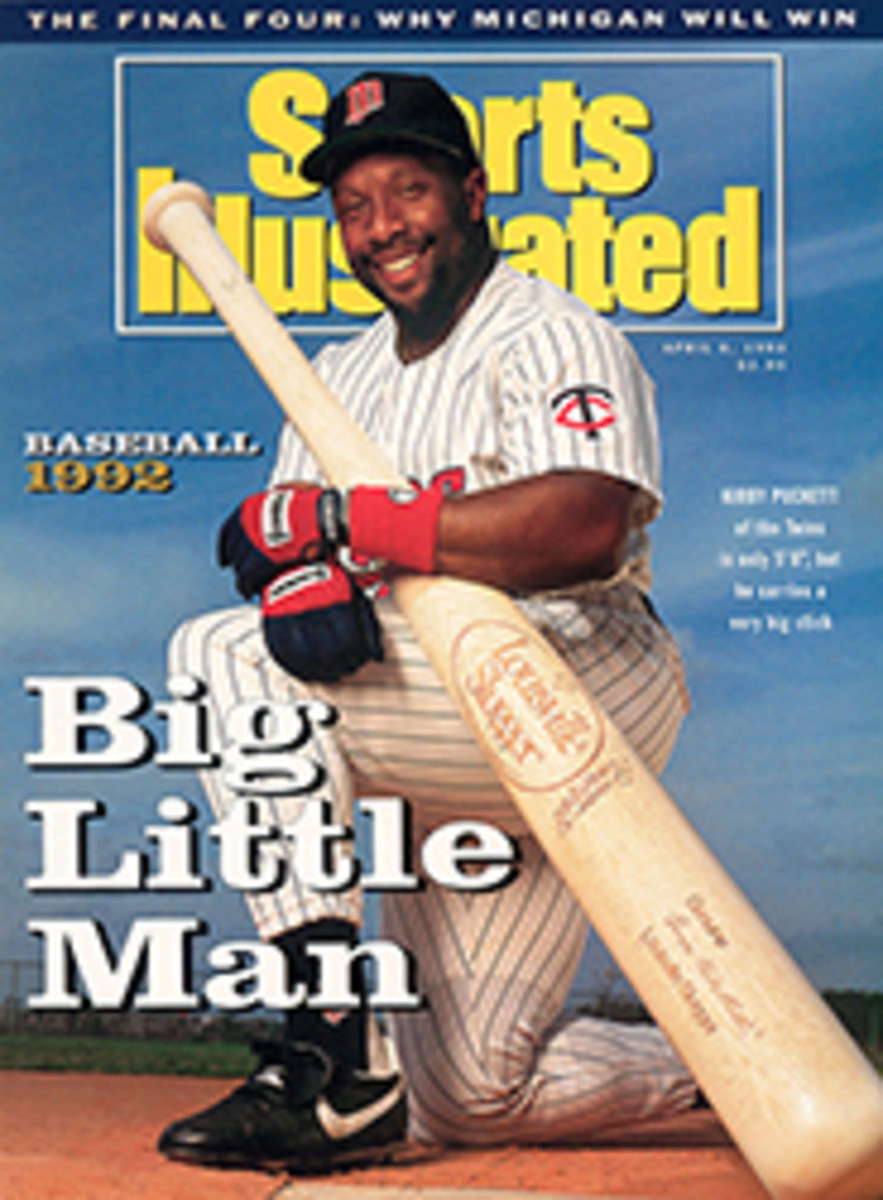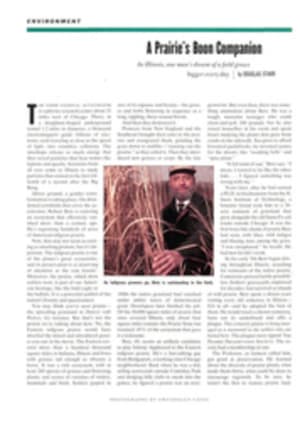
A Prairie's Boon Companion
The Fermi national accelerator is a physics research center about 35 miles west of Chicago. There, in a doughnut-shaped underground tunnel 1.2 miles in diameter, a thousand electromagnets guide billions of electrons, each traveling at close to the speed of light, into countless collisions. The smashups release so much energy that they reveal particles that bear names like leptons and quarks. Scientists from all over come to Illinois to study particles that existed in the first trillionth of a second after the Big Bang.
Above ground, a gentler transformation is taking place. On abandoned cornfields that cover the accelerator, Robert Betz is restoring an ecosystem that effectively vanished more than a century ago. He's regrowing hundreds of acres of American tallgrass prairie.
Now, that may not seem as exciting as smashing protons, but it's important. The tallgrass prairie is one of the planet's great ecosystems, and its preservation is as deserving of attention as the rain forests'. Moreover, the prairie, which drew settlers west, is part of our American heritage, like the bald eagle or the buffalo. It is a powerful symbol of the nation's bounty and spaciousness.
You may think you've seen prairie—the spreading grassland in Dances with Wolves, for instance. But that's not the prairie we're talking about here. No, the Eastern tallgrass prairie would have dwarfed the mixed and introduced grasses you saw in the movie. The Eastern covered more than a hundred thousand square miles in Indiana, Illinois and Iowa with grasses tall enough to obscure a horse. It was a rich ecosystem, with at least 200 species of grasses and flowering plants, and scores of varieties of snakes, mammals and birds. Settlers gasped in awe of its expanse and beauty—the grasses and forbs flowering in sequence as a long, rippling, three-season bloom.
And then they destroyed it.
Pioneers from New England and the Southeast brought their cows to the prairies and overgrazed them, grinding the grass down to stubble—"running out the prairie," as they called it. Then they introduced new grasses or crops. By the late 1800s the native grassland had vanished under amber waves of domesticated grain. Developers later finished the job. Of the 40,000 square miles of prairie that once covered Illinois, only about four square miles remain; the Prairie State has retained .01% of the ecosystem that gave it a nickname.
Betz, 69, seems an unlikely candidate to play Johnny Appleseed to the Eastern tallgrass prairie. He's a fast-talking guy from Bridgeport, a working-class Chicago neighborhood. Back when he was a kid, selling scorecards outside Comiskey Park and dodging billy clubs to sneak into the games, he figured a prairie was an over-grown lot. But even then, there was something anomalous about Betz. He was a tough, muscular teenager who could clean-and-jerk 280 pounds, but he also raised houseflies in his room and spent hours studying the plants that grew from cracks in the sidewalk. Too poor to afford botanical guidebooks, he invented names for the shoots, like "wedding bells" and "spice plant."
"It felt kind of sad," Betz says. "I mean, I wanted to be like the other kids.... I figured something was wrong with me."
Years later, after he had earned a Ph.D. in biochemistry from the Illinois Institute of Technology, a botanist friend took him to a 30-acre remnant of grassland that grew alongside the old Santa Fe rail tracks outside Chicago. It was the first bona fide chunk of prairie Betz had seen, with lilies, wild indigos and blazing stars among the grass. "I was enraptured," he recalls. He had met his life's work.
In the early '60s Betz began driving throughout Illinois, searching for remnants of the native prairie. Cemeteries proved fertile possibilities. Settlers' graveyards, unplowed for decades, had survived as islands of wild prairie. Betz spent a dozen years visiting every old cemetery in Illinois—824 in all—and he adopted the best of them. He would weed a chosen cemetery, burn out its underbrush and affix a plaque: This cemetery prairie is being managed as a memorial to the settlers who are buried here. The plaques were signed: THE PRAIRIE PRESERVATION SOCIETY. The society had a membership of one.
The Professor, as farmers called him, got good at preservation. He learned about the diversity of prairie plants, what made them thrive, what could be done to encourage regrowth. To be sure, he wasn't the first to restore prairie land. Back in the 1930s, when the Dust Bowl shook people's faith in some of the methods of modern agriculture, the pioneer conservationist Aldo Leopold advocated returning some farmland to its presettlement condition. Two of Leopold's colleagues at the University of Wisconsin, Ted Sperry and John Curtis, replanted a small prairie at that school's arboretum. Ray Schulenberg of the Morton Arboretum near Chicago followed suit. But theirs were small plots of several dozen acres. Betz wanted something big. He dreamed of great expanses that reached the horizons, parcels voluminous enough to attract insects, birds and mammals...a working prairie ecosystem. His vision required hundreds of acres.
In the late '60s word got around that the government was buying up farms in Kane County for an underground accelerator. Betz quickly saw a perfect use for all that vacant land. In 1972 he made a proposal to Robert Wilson, the eminent physicist who headed the Fermi lab. As it happened, Wilson, too, wanted to do something wild, if yet undefined, with the aboveground site. He already had bought a few buffalo and set them loose. Then along came Betz.
"He told me that growing a real prairie could take two hundred years," recalls Wilson, now a professor emeritus at Cornell University. "I said, 'Then we'd better start this afternoon.' "
Three years later, the lab's ground crew plowed 10 acres of old cornfield inside the area that covered the accelerator ring. Betz and a small army of volunteers then sowed about 400 pounds of seeds collected from remnant prairies. Within a few weeks broad-leaved vegetation was matting the ground. Weeds. Their seeds had been lying dormant in the soil. "We thought we were a goner," says Betz. But when he crept around on his hands and knees, he could see tiny prairie grasses beginning to push through. By the next year the sprouts had grown a few inches. The prairie plants were beginning to catch up with the weeds, and in the second year Betz and his crews added 10 more acres. The third year they added another 32.
By that third year, back at the first plot, the grasses had reached six feet and were growing fast. Betz set them on fire. He had read settlers' accounts of natural prairie fires and thought they must have served an ecological function. He thought right: A few weeks after Betz's blaze, the prairie grasses returned thicker than before. "They just shot up," says Betz. "They consolidated their position. The fire must have killed off most weeds, while sparing the deep-rooted prairie species." Betz moved forward, plowing and seeding new sections in late spring or early summer, burning different sections of the prairie at the end of winter. Piece by piece, the prairie grew.
Over the years, Betz noticed that regardless of how many species of seeds he planted in a newly plowed plot, only one or two dozen kinds would sprout. He examined the soil. Real prairie soil is spongy, interlaced with fine roots and other organic matter—it holds moisture well. But this stuff crumbled in his fingers like sand. More than a century of farming had ruined its physical structure. Such soil could never support a full load of prairie plants.
Betz found, however, that some prairie grasses could grow in the bad ground, and that they would alter the soil, adding a new mixture of roots and stems. This altered soil could host a second wave of slightly more delicate plants. Then the second wave would prepare the soil for a third. Betz began planting in strategic waves: first-wave species like big bluestem, followed a few years later by second and third wavers—flowering plants, like the blue aster, that require more water. Betz, who theorizes that a mature prairie might require five waves in all, has taken parts of his field through the third wave, and they are now supporting such finicky plants as shooting stars. The restoration has already returned 120 native plant species to the prairie. Betz has, he figures, squeezed 40-50 years of prairie evolution into 15.
Today, the native grassland spreads across 800 acres inside and outside of the ring. As John Peoples, now Fermi's director, oversees the collisions in the lab below, the grasses climb slowly, inexorably toward the sun. Animals such as turtles, coyotes and beaver have returned to the area. Ron Panzer, a biologist at Northeastern Illinois University who has surveyed the prairie, says it now shelters about 90% of the insect species of its pre-settlement days. Birds like the snowy egret, red-tailed hawk and sandhill crane have returned. In fact, so many rare birds now stop at the site that bird-watchers have objected to Betz's periodic burnings.
Betz, who has been awarded a dozen citations from scientific societies—and even one from the United Nations—is unfazed by his success. He's most pleased that he now has a place to go out tramping, to push his way through the shoulder-high grass, spinning new ideas. He reaches a spot in the center of the ring and gazes across grassland that stretches to the horizon. "You know?" he says. "In 50 years this is going to be really nice."
PHOTO
GWENDOLEN CATES
As tallgrass growers go, Betz is outstanding in the field.
PHOTO
GWENDOLEN CATES
Lab director Peoples oversees the space-age environment hidden beneath the prairie.
Douglas Stair co-directs the graduate Program in Science Journalism at Boston University.

